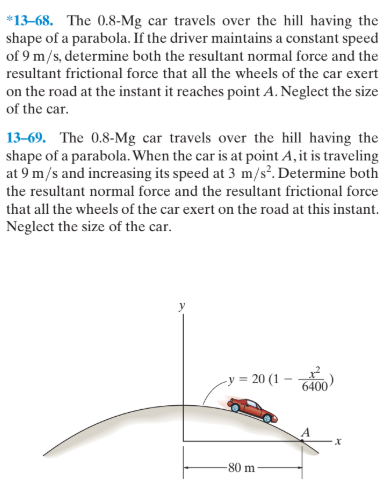
Elements Of Electromagnetics
7th Edition
ISBN: 9780190698614
Author: Sadiku, Matthew N. O.
Publisher: Oxford University Press
expand_more
expand_more
format_list_bulleted
Question

Transcribed Image Text:*13-68. The 0.8-Mg car travels over the hill having the
shape of a parabola. If the driver maintains a constant speed
of 9 m/s, determine both the resultant normal force and the
resultant frictional force that all the wheels of the car exert
on the road at the instant it reaches point A. Neglect the size
of the car.
13-69. The 0.8-Mg car travels over the hill having the
shape of a parabola. When the car is at point A, it is traveling
at 9 m/s and increasing its speed at 3 m/s?. Determine both
the resultant normal force and the resultant frictional force
that all the wheels of the car exert on the road at this instant.
Neglect the size of the car.
-y = 20 (1 -
6400
80 m
Expert Solution
This question has been solved!
Explore an expertly crafted, step-by-step solution for a thorough understanding of key concepts.
This is a popular solution
Trending nowThis is a popular solution!
Step by stepSolved in 5 steps with 1 images

Knowledge Booster
Similar questions
- The drop gate at the end of the trailer has a mass of 1000 kg and mass center at G. If it is supported by the cable AB and hinge at C. determine the tension in the cable when the truck begins to accelerate at 5 m/s2 to the left.arrow_forward2. The 10-Ib block has a speed of 4 ft's when the force of F= (8t?) Ib is applied. Determine the velocity of the block when t= 2 s. The coefficient of kinetic friction at the surface is = 0.2. v = 4 ft/s F= (8°) lbarrow_forwardsolve, answer is provided, show all steps.arrow_forward
- The 1.334-Mg car is traveling along the curved road described by r = (50e28) m, where 0 is in radians. If a camera is located at A and it rotates with an angular velocity of Ó = 0.083 rad/s and an angular acceleration of ö = 0.304 rad/s? at the instant 0 = 0.879 rad, .determine the resultant friction force developed between the tires and the road at this instant %3D r= (50")marrow_forwardF 15° 0.6 m 1 m The crate has a mass of 58 kg and rests on the inclined platform of the truck. Determine the minimum acceleration that will cause the crate to tip over or slide relative to the forklift. What is the magnitude of this acceleration? The coefficient of static friction between the packaging and the truck is µs= 0.7.arrow_forward
arrow_back_ios
arrow_forward_ios
Recommended textbooks for you
 Elements Of ElectromagneticsMechanical EngineeringISBN:9780190698614Author:Sadiku, Matthew N. O.Publisher:Oxford University Press
Elements Of ElectromagneticsMechanical EngineeringISBN:9780190698614Author:Sadiku, Matthew N. O.Publisher:Oxford University Press Mechanics of Materials (10th Edition)Mechanical EngineeringISBN:9780134319650Author:Russell C. HibbelerPublisher:PEARSON
Mechanics of Materials (10th Edition)Mechanical EngineeringISBN:9780134319650Author:Russell C. HibbelerPublisher:PEARSON Thermodynamics: An Engineering ApproachMechanical EngineeringISBN:9781259822674Author:Yunus A. Cengel Dr., Michael A. BolesPublisher:McGraw-Hill Education
Thermodynamics: An Engineering ApproachMechanical EngineeringISBN:9781259822674Author:Yunus A. Cengel Dr., Michael A. BolesPublisher:McGraw-Hill Education Control Systems EngineeringMechanical EngineeringISBN:9781118170519Author:Norman S. NisePublisher:WILEY
Control Systems EngineeringMechanical EngineeringISBN:9781118170519Author:Norman S. NisePublisher:WILEY Mechanics of Materials (MindTap Course List)Mechanical EngineeringISBN:9781337093347Author:Barry J. Goodno, James M. GerePublisher:Cengage Learning
Mechanics of Materials (MindTap Course List)Mechanical EngineeringISBN:9781337093347Author:Barry J. Goodno, James M. GerePublisher:Cengage Learning Engineering Mechanics: StaticsMechanical EngineeringISBN:9781118807330Author:James L. Meriam, L. G. Kraige, J. N. BoltonPublisher:WILEY
Engineering Mechanics: StaticsMechanical EngineeringISBN:9781118807330Author:James L. Meriam, L. G. Kraige, J. N. BoltonPublisher:WILEY

Elements Of Electromagnetics
Mechanical Engineering
ISBN:9780190698614
Author:Sadiku, Matthew N. O.
Publisher:Oxford University Press

Mechanics of Materials (10th Edition)
Mechanical Engineering
ISBN:9780134319650
Author:Russell C. Hibbeler
Publisher:PEARSON

Thermodynamics: An Engineering Approach
Mechanical Engineering
ISBN:9781259822674
Author:Yunus A. Cengel Dr., Michael A. Boles
Publisher:McGraw-Hill Education

Control Systems Engineering
Mechanical Engineering
ISBN:9781118170519
Author:Norman S. Nise
Publisher:WILEY

Mechanics of Materials (MindTap Course List)
Mechanical Engineering
ISBN:9781337093347
Author:Barry J. Goodno, James M. Gere
Publisher:Cengage Learning

Engineering Mechanics: Statics
Mechanical Engineering
ISBN:9781118807330
Author:James L. Meriam, L. G. Kraige, J. N. Bolton
Publisher:WILEY